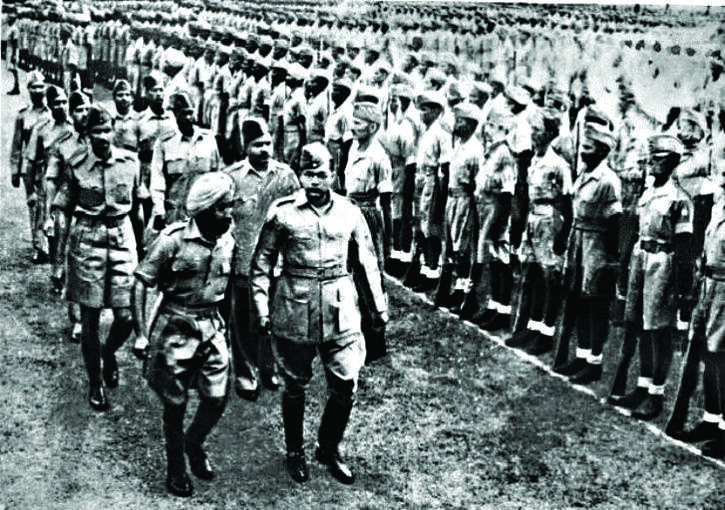Tricolour over the Islands
Even after the official handover of the islands to the INA, Japanese — who had occupied those from the British — were known to have inflicted atrocities over local inhabitants before they left

The next major milestone in the history of the islands was its abdication by the British during the Second World War, and the smooth takeover by the Japanese, who were initially welcomed by the inhabitants of both the islands. The garrison at Port Blair consisted of a 300-man Sikh militia with 23 British officers, augmented in January 1942 by a Gurkha detachment of the 16th Indian Infantry Brigade. Following the fall of Rangoon, the British recognized that Port Blair had become impossible to defend, and the Gurkhas were withdrawn to the Arakan peninsula. In March 1942, the garrison offered no resistance to the Nippon landings. The troops were disarmed but most members of the Sikh militia enlisted in the Indian National Army which had been established by Subhas Chandra Bose The army was first formed in 1942 by the Indian soldiers of the British-Indian Army in Malaysia and Singapore. It got a fillip when Subhas Bose took over as the Supreme Commander of the INA after he arrived in Southeast Asia in 1943. The army was affiliated with the Arzi Hukumat-e-Azad Hind (the Provisional Government of Free India). The brigades/regiments of INA after Gandhi, Nehru, Maulana Azad, and himself. In the early days of the occupation local intellectuals (mostly officials and doctors) were encouraged to join Rash Behari Bose's Indian Independence League, and a 'Peace Committee' was formed from its members, headed by Dr Diwan Singh.
Meanwhile, on December 29, 1943, Netaji accompanied by Anand Mohan Sahay, Captain Rawat - ADC and Col. DS Raju, the personal physician of Netaji, landed at the Port Blair aerodrome in the Andamans. He was received by the Japanese admiral at Port Blair. The enthusiastic Indians and Burmese also accorded a warm reception to him. The Indian tricolour was hoisted by him on December 30, 1943. Bose named Andaman Island as Shaheed and Nicobar Island as Swaraj and appointed INA General AD Loganathan as the governor of the Islands. Azad Hind Government was not merely a Government in Exile anymore but had its own land, own currency, civil code, and stamps.
However, even though the islands were formally handed over to the INA, the Japanese troops behaved like an army of occupation. Amongst the first victims was a young man, Zulfikar Ali who took umbrage at the unauthorised entry of troops into his house. Although no one was hurt in the air gun firing, Zulfiqar Ali was captured and marched to the maidan. Here his arms were twisted until they broke, and he was then shot. The memorial to him is now called Sunny's Mazar. Later Dr Diwan Singh and most other members of the IIL were also arrested, tortured, and killed.
Although the Japanese burnt all the records before they surrendered, the reconstruction of the period of Japanese occupation is documented in Jayant Dasgupta's Red Sun over Blackwaters. Dasgupta refers to the hitherto unpublished accounts of a local resident Rama Krishna The Andaman Islands under Japanese Occupation 1942-5, by a British officer, D. McCarthy: The Andaman Interlude. From these records, it appears that as food became scarce, the Japanese forced the residents of Port Blair to move to uninhabited islands, and many were drowned or bayoneted or shot when they tried to escape. TR Sareen, however, gives a more nuanced picture of the role of the Azad Hind Fauj and the role of Subhas Bose. He holds the blockade of the islands by the British as the principal reason for the acute shortage of food and argues that the Japanese authorities were trying to send people from Port Blair to uninhabited islands to bring new land under the plough.
In December 2018, the 75th anniversary of Netaji Subhash Chandra Bose's hoisting the national flag at Port Blair was commemorated with the renaming of three of the most frequented islands in the archipelago.
Ross Island was renamed Netaji Subhas Chandra Bose Dweep, Neil Island as Shaheed Dweep and Havelock Island as Swaraj Dweep. It was the fulfilment of a long-standing demand that the islands should not be named after the colonial masters, two of whom - Havelock and Neil - both commanders of the British Indian army had the blood of thousands of Indians on their hands. Ross was an exception – he was a marine biologist who spent his time documenting the underwater beauties in the surrounding seas. It served as the capital of the Islands till a major earthquake destroyed the facilities, and subsequently, the administration shifted to Port Blair. Subhas Bose had however landed on this island, which is now named after him.
Views expressed are personal



